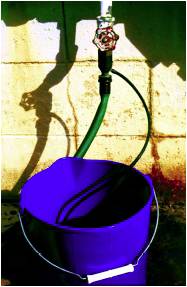SPRAYER CALIBRATION (siphoning bucket)
GOOD NEWS About Siphoning Bucket Sprayers
Bucket sprayers are relatively inexpensive.
The fatigue factor is minimal. The bucket containing the product does not have to be carried; it remains stationary during the application.
Various spray patterns can be selected. Interchangeable nozzles for the garden hose allow the user to change the spray pattern as desired.
They’re versatile. The siphoning equipment can be used to treat many sizes and shapes of plants, ranging from small shrubs to medium-sized trees. Buckets of various sizes can be used, depending on the size of the job.
BAD NEWS About Siphoning Bucket Sprayers
Contamination of the garden hose can be a problem. Small amounts of pesticide may be left inside the hose, and the outside of the hose may become contaminated as it is dragged across the lawn during application. Never drink water from a hose that is used to apply pesticides
Application distance from the water faucet is limited. It is generally recommended that no more than 50 feet of garden hose be used with bucket sprayers; this, of course, limits their usefulness to a radius of 50 feet from the water faucet.
Bucket sprayers are difficult to monitor. The bucket containing the product often is left unattended and out of sight while the user is spraying. This poses a threat to small children and pets playing nearby and limits the applicator’s
HOW DO I CALIBRATE A SIPHONING BUCKET SPRAYER? (For spraying plants)
With siphoning bucket sprayers, a bucket is placed next to the water faucet and a siphoning device is positioned between the faucet and a garden hose.
One end of the siphon is screwed directly onto the faucet, and the other is attached to the hose. A small rubber tube is attached to one side of the siphoning device and its free end placed in a bucket containing the pesticide mixed with a little water.
 As water flows through the siphoning device, it creates suction that pulls the product out of the bucket, through the tube and injects it into the stream of water moving through the garden hose.
As water flows through the siphoning device, it creates suction that pulls the product out of the bucket, through the tube and injects it into the stream of water moving through the garden hose.
An adjustable nozzle that can turn the water on and off is attached to the opposite end of the hose, allowing the applicator to alter the spray pattern. The operation is similar to that of a hose-end sprayer.
The siphoning device proportions the product in a ratio of 16:1. That is, for every 16 gallons of water flowing through the siphon and into the hose, one gallon of product is pulled from the bucket into the water flow and mixed uniformly. This ratio must be considered when mixing the pesticide concentrate with water in the bucket. The concentration of the bucket mixture must be computed so that, when it is being mixed with water flowing through the hose, the correct concentration exits the nozzle at the opposite end of the hose.
Calibration Steps |
Sample Problem |
| 1. Attach the siphon device to the faucet and the garden hose. Attach the nozzle to the opposite end of the hose and make sure the valve is turned off.
Do not add pesticides at this time. Put plain water in the bucket and drop the siphon tube into the water. Turn on the water at the faucet, then at the end of the hose. Spray the rose bushes with the water and record the amount of time required to treat all of the plants. |
5 minutes to treat
25 rose bushes |
| 2. Determine how much water was used in one minute. Spray water into a second bucket and measure the amount collected in one minute | 2 gallons of water collected in 1 minute |
| 3. Determine how much water is required for the entire job. | 2 gal / min x 5 min = 10 gal |
| 4. Compute the amount of pesticide product required for the job. | 1.5 fl oz / gal x 10 gal = 15 fl oz |
| 5. Compute the amount of water and pesticide to add to the bucket when the delivery ratio for the siphoning device is 16:1.
Since only 10 gallons of water will be required for the job, you’ll need a 10/16 mix in the bucket |
16 gal water passing through the hose will withdraw 1 gal of liquid from the bucket
10 + 16 = 0.625 gal 0.625 gal x 128 oz /1 gal =80oz Since 15 fl oz of the product (Step 4) is required for the job, the actual amount of water needed is 80 fl oz – 15 fl oz = 65 fl oz |
| 6. Mix 15 fl oz of pesticide product with 65 fl oz of water in the bucket. | First, put the 15 fl oz of pesticide into the bucket. Then add 65 fl oz of water to bring the level up to 80 fl oz. Stir to mix |